Description of culture
Apricot Countess grows into a fairly tall and vigorous tree with a rounded crown. Its height reaches 5.5-6 m. The foliage is quite large. The flowering period begins several days later than other varieties. Numerous inflorescences do not exceed 2.5 cm. Each of the leaf axils is endowed with many buds of the generative type. Stamens are underdeveloped. Normal pollen does not form on anthers colored white. The fruit tree is pollinated with pollen from other varieties. The productivity of the variety is at a high level.
Ripe fruits are round or oval in shape. The variety is quite capricious and sensitive to changing weather conditions. In cases where the summer is hot and dry, the fruits grow clean and beautiful. Their weight reaches 25 g. With average harvests, the fruits increase in size up to 40 g. The bright orange, dense and very juicy pulp is covered with a thin skin, which is colored in cream or pale yellow tones. A peculiar blush can be seen on all fruits. According to data on the chemical composition of apricot, the fruit consists of:
- dry matter – 13.8%;
- sugar – by 7.7%;
- titratable acid – 1.8%.
For every 100 g of fruit weight there are 660 mg of potassium. The Countess stone grows to a large size (11.5%), but separating it from the pulp is not difficult.
Growing the Countess apricot is possible in the Moscow region and other cities with a warm climate. Reviews of the Countess apricot in the Moscow region confirm the high level of productivity in the region and the timely ripening of the fruit.
Description of the variety, history of occurrence
The Countess is included in the collection of the Moscow State University Botanical Garden. The apricot variety was bred in 1988 by co-authors L. A. Kramarenko and A. K. Skvortsov. Scientists were engaged in the selection of crops for cultivation in Moscow and the region. Apricot has been on the State Register since 2004.
Trees grow quickly. They can reach 6 meters in height. The crowns are round, paniculate, and medium dense.
The level of frost resistance of apricot is quite good. The tree can withstand cold temperatures down to -30 degrees. Only the buds do not tolerate recurrent frosts.
In the description of the variety, the fruits are characterized as follows:
- color - light yellow;
- the peel is thin;
- juicy orange pulp;
- taste - sweet and sour.
Characteristics of the Countess apricot variety
Drought resistance, winter hardiness of the variety
The frost resistance of the tree is excellent. Apricot can withstand frosts down to -25, 30 °C. However, during the flowering period, the buds will not tolerate the return of severe frost.
The fruit tree does not need abundant watering, so it tolerates long periods of drought.
Pollination, flowering period and ripening time
The Countess is growing up quite quickly. The height of the tree in some cases can even exceed 6 m. Considering the fact that the variety is not capable of self-pollinating, trees of other varieties should be planted next to the apricot.
The variety needs nearby pollinators. The best pollinators for apricot Countess:
- Lel;
- Northern Triumph;
- Favorite;
- Monastic.
The flowering period of the variety begins several days later than the ordinary apricot. You can enjoy the first fruits closer to August 10-15. Full ripening of the crop continues until the end of summer.
Productivity, fruiting
The harvest of the Countess variety is generous, amounting to 25-30 kg per tree. Each of the branches of the fruit tree is literally strewn with large fruits.
Area of application of fruits
A high-yielding apricot variety is canned and frozen. Fans of strong drinks make apricot liqueur at home.
Resistance to diseases and pests
Resistance to diseases and pests depends on weather conditions. If the summer is dry and hot, the fruits will be large and clean. In rainy, cool summers the tree is susceptible to cleasterosporia blight. The disease spoils the appearance of the crop. Black spots appear on the skin, which can be small in size or cover a significant part of the surface of the fruit. Sometimes severe gum leaks occur.
Advantages and disadvantages
Advantages of apricot variety Countess:
- large fruit size;
- early and long period of fruiting;
- high level of resistance to various pests and diseases;
- remarkable winter hardiness of the variety;
- good transportability;
- abundant fruiting.
It is also worth highlighting the high tasting rating of the variety.
Among the disadvantages it is worth noting:
- change in taste characteristics depending on the weather;
- reduction in fruit size with abundant harvest;
- susceptibility to infection with clasterosporiosis and the occurrence of gum discharge during a prolonged rainy period.
How to prune correctly
One of the features of apricots and all stone fruits is the high activity of the buds - almost all those that hatch begin to grow. Moreover, the fruits are formed mainly on branches that grew last year, or on bouquet branches, spurs and other fruit formations. Their lifespan is usually about three years.
As a tree ages, its growth processes are inhibited. Flower buds are formed only on short shoots, and at the end of fruiting these branches become bare. And because of the short life of bouquet branches, older branches also become bare. Therefore, adult apricots need to maintain growth processes, and this is what you need to focus on when pruning.
Pruning a columnar apricot is a very important point. It is best to stick to the tiered form (see photo), highlighting 5-6 main branches and leaving about 40 cm of distance between them. Correction of the crown shape begins in the first year of the plant’s life.
- If, when planting in spring, the seedling has no branches, it is cut off at a height of 80-90 cm.
- If there are lateral branches, then two of them are left, if possible those directed along the row, and shortened by half.
- All other branches are cut into a ring. The length of the central conductor should be cut 20-25 cm longer than the rest of the branches.
In summer, all competitive shoots that form at an acute angle are removed. In subsequent years, 3-4 more main branches are selected and pruned, on which branches will then form. The recommended distance between them is 35-40 cm.
To form a beautiful crown, you need to ensure that the upper shoots do not overtake the lower ones. If there are excess shoots, they can be shortened by turning them into fruit branches.
Once the desired crown shape is achieved, all that remains is to maintain it. To do this, you need to maintain the active growth of shoots by pruning them by shortening them by a third (if the branching of this variety is good) or by half. If the tree grows very quickly, additional pruning can be done in the summer, shortening the shoots by half or a quarter, depending on the intensity of growth.
Features of planting the variety
Planting and caring for Countess apricots does not require special knowledge and skills. Even a novice gardener can grow it.
Choosing a suitable location
The most important thing is to choose the right place before planting, since the Countess apricot variety will not bear fruit and bloom if it is constantly in the shade and there is no nearby pollinator tree. The area that was chosen for planting must be dry, well lit and ventilated.
Selection and preparation of planting material
An annual or biennial tree, the height of which exceeds 50 cm, is best suited as planting material. The roots of a high-yielding variety seedling should be strong, healthy and not show signs of wilting or obvious damage by diseases and pests. It is important that the grafted part of the plant is mature and strong enough. The bark of the variety seedling should be colored brown.
Recommended timing
It is recommended to plant a seedling of a high-yielding variety in the spring, when the buds have not yet bloomed. A hole is dug in a pre-selected place and filled with a nutrient mixture:
- 2 kg of rotted compost;
- 35 g superphosphate;
- 25 g potassium salt;
- 15 g wood ash.
The mixture is thoroughly mixed with the soil. The seedling must be watered abundantly, mulched and the top trimmed so that the height of the tree is 60-65 cm.
Landing algorithm
Before planting an apricot, you should inspect its root system. If there are damages on it, it is recommended to cut them off. Then they prepare a mash based on mullein, water and earth and dip the root in it.
- Prepare a pit, the size of which is 50x50x50 cm.
- A mound of earth is formed on the surface of the bottom of the pit. A peg is driven in at this point for support.
- Lower the apricot into the hole so that the root collar is located 5-6 cm above the ground level.
- Cover the root system with the top layer of soil and compact the area around the apricot.
- A hole is formed around the circumference of the fruit tree, the diameter of which should be 60-70 cm.
- Using a rope, tie the tree to the peg.
- Water a seedling of a high-yielding variety with 25 liters of water. Then mulch the hole with wood shavings.
- If necessary, trim the seedling so that its height does not exceed 65 cm.
If you deeply deepen the root collar into the hole, the growth of the plant will begin to be inhibited.
Features of growing apricot Kichiginsky
Caring for the Kichiginsky apricot is generally simple, but there are some features associated with the region where the crop is grown. They are caused by the climatic conditions of the Urals and Siberia, which are characterized by low temperatures in winter and spring frosts and thaws. In southern latitudes, Kichiginsky is not widespread due to the presence of a large assortment of this crop for warm climates.
Landing
Plant apricots in an open sunny place where there is no wind. To reduce the risk of the root collar becoming warm when planting Kichiginsky, it is also necessary to ensure that a lot of snow does not accumulate at the planting site in winter. You can plant an apricot on a mound, but in very snowy winters this technique does not always save.
To prevent the root collar from becoming warm, the apricot is planted on a mound.
If it is difficult to find a good place to plant an apricot, then you will have to take preventive measures to prevent overheating.
As soon as the first snow falls, you need to immediately free the trunk from it so that the soil under the root collar freezes as deep as possible. At the end of winter (before the start of thawing), in the tree trunk circle at a distance of up to one and a half meters from the trunk, you need to thoroughly clear the ground of snow. It is also necessary to dig grooves to drain melt water.
The recommended planting pattern for Kichiginsky is 3x5 m. On heavy soils, drainage is placed at the bottom of the planting hole to regulate the humidity level. Otherwise, when planting Kichiginsky, standard requirements are observed, as for other representatives of this culture.
Video: how to properly plant apricots in the Urals
Apricot care Kichiginsky
Given the complexity of climatic conditions, the seedling should be protected from possible freezing for the first 3–4 years after planting. You can make a frame and cover it with film or spunbond. A simpler option would be to wrap it, for example, in burlap or any other materials through which the plant receives oxygen.
One of the options for covering a young apricot for the winter using a frame
Apricot Kichiginsky can grow quite tall, so it is better to use a sparsely tiered crown formation. Since the tree is not prone to thickening, it will be possible to do without regulatory pruning. But it is not recommended to neglect sanitary pruning; it must be carried out at the end of autumn.
Apricot is considered to be drought-resistant. Yes, if there is a lack of moisture, the tree will not die, but it will affect the harvest. Therefore, apricots need to be watered 3-4 times per season; they especially need moisture immediately after flowering and during intensive fruit growth.
If the holes were filled with organic fertilizers during planting, then they begin to be applied after 3–4 years. Feed with complex mineral fertilizers annually.
Nitrogen fertilizers for feeding can be used only until mid-summer, and it is also better to combine them with potassium and phosphorus.
Video: practicing gardeners about fertilizing apricots
Apricot is quite resistant to disease and rarely gets sick when the weather is favorable for it. In years when the summer is cold and rainy, fungal diseases may appear.
Table: possible apricot diseases and their signs
| Disease | Signs |
| Moniliosis (monilial burn) | Shoots and leaves turn black and dry out, and the fruits rot. |
| Clusterosporiasis (hole spotting) | Leaves and fruits are affected. Pinpoint fungal infections appear on the leaves, in place of which holes form. Dots also appear on the fruits, which grow until the berries are completely covered with scabs. |
| Cytosporosis | Most often it affects skeletal wood. Necrosis and gum formation appear, the bark begins to crack and peel. Skeletal branches or the entire tree may dry out. |
Photo gallery: common fungal diseases of apricot
To prevent fungal diseases, trees are sprayed with a 3% solution of Bordeaux mixture or other fungicides in accordance with the instructions.
Subsequent care of the crop
After planting, the apricot variety Countess requires systematic care:
- It is important to carry out annual pruning in late March. Problematic apricot branches must be removed, and the number of healthy shoots must be regulated.
- Form the crown of the tree, choosing a sparsely tiered form.
- Water generously, especially during periods of flowering, the growth of new shoots and a couple of weeks before harvest. It is recommended to moisten the soil in the area of the tree trunk to a depth of 25-35 cm. In autumn, it is best to generously fill the tree so that the water penetrates to a depth of more than 0.5 m.
- Apply fertilizing in a timely manner to ensure a high yield and large fruits. The first time after planting a seedling, it needs to be fertilized 2 years later. To make fertilizer, you will need to mix 40% potassium salt, 5 kg of rotted manure and 60% nitrogen compound. You can also purchase a complex preparation for feeding that contains iron, boron, and manganese.
- Before the onset of the first frost, it is important to cover the tree with a wooden cone, which is wrapped in durable cloth, and sprinkle it with soil. Carrying out these activities will allow the young tree to avoid freezing.
Agricultural technology for growing varieties on the site
Growing an apricot tree is a simple process. If you follow all the rules for choosing high-quality planting material and the area on which the crop will grow, you can grow a healthy and strong tree that will delight you with a bountiful harvest.
Selecting a location
The crop is grown in a well-lit area, which will help improve the taste of the fruit. When choosing a site, you should pay attention to the height of the groundwater, which should be at least 1.5 m deep so that the rhizome is not subject to rotting.
The soil in the selected area should be light, not oxidized, otherwise the plant will often be susceptible to diseases. You should not plant a tree in a draft to prevent the plant from being attacked by pests and becoming infected with fungal spores carried by the wind.
Selection of quality seedlings
Apricot tree seedlings must be purchased from specialized nurseries. It is imperative to check the graft mark, which will guarantee the authenticity of the variety. 2-year-old trees take root best, the rhizome of which should be up to 40 cm and the trunk height 1 m. When choosing a seedling, a thorough inspection is carried out for diaper rash and rotten parts of the rhizome.
If there are still 3-4 weeks before planting, and the seedling has already been purchased, then you should take care of its safety. The plant is placed in a cool room at a temperature of +5°C. The root system must be wrapped in thick paper or burlap and ensure good moisture. Seedlings can be buried in the area, which requires simply sprinkling the rhizome with soil and constantly carrying out moisturizing procedures.
Direct planting technology
It is better to plant seedlings in the spring, so that over the summer the plant gets stronger and gains nutrients for the winter. Planting is carried out in mid-April, when the air temperature warms up to +15°C.
The soil for planting is prepared six months before the procedure, it is dug to a depth of 30–40 cm mixed with manure in an amount of 5 kg per m², and 200 g of wood ash per m² of land is also added for digging.
The fertile layer of soil is mixed with 10 kg of humus, 60 g of superphosphate, 30 g of potassium and 100 g of wood ash. The prepared substrate is poured to the middle of the hole and left in this position until the actual process of planting the seedling.
Apricot tree planting technology:
- The soil in the hole needs to be loosened and formed into a mound.
- Drive a stake into the middle of the hole, which will rise 1 m above the soil level.
- Insert the planting material into the hole, carefully straightening the rhizome along the earthen hill.
- Fill the top of the hole with soil and compact it.
- Form a near-trunk circle by forming a mound around the trunk at a distance of 50–60 cm from it.
- Water the tree with a bucket of warm water (10 l).
- Mulch the area near the trunk with peat to a depth of 5 cm.
Harvesting, processing and storage of the Countess variety
The fruit tree begins to bear fruit 3 years after planting in mid-August. In the first years of fruiting, 20-25 kg of fruit is harvested, and an adult tree produces more than 60 kg of fruit annually. Harvesting has to be done in stages, as stone fruits do not ripen simultaneously. If you send the harvest in a wooden box in a room where the temperature is kept at 0°C, you can preserve both appearance and taste for 30-50 days. Fruits can also be dried and frozen.
Apricots of the Countess variety can be consumed fresh or used to prepare:
- compote;
- jam;
- jam;
- confiture;
- marmalade;
- alcoholic drinks;
- confectionery fillings.
Types of propagation of ornamental apricot
Despite the fact that the culture is listed in the Red Book, it propagates quite easily and quickly using seeds or cuttings. The most interesting thing is that even when planting seeds, all parental qualities are completely preserved.
Seeds
If possible, you can collect the seeds yourself or order them from a nursery. They are usually packaged in 10–20 pcs. in a bag. They retain their ability to germinate for 2 years from the date of collection. Before planting, they are soaked in water for about a day. Then those that float are discarded, and those that settle to the bottom are placed in a pot with sand. The seeds are kept at a temperature of 0°C in a dark room for 3 months.
Video: How to plant Manchurian apricot from a seed
After this, they are planted in a greenhouse or in separate pots. If you use pots, it is better to immediately take self-decomposing peat ones. Sow the seeds to a depth of 1 cm. Prepare loose, nutritious soil for the seeds. To do this, mix peat, compost, and sludge in equal proportions and add 20% of the total mass of wood ash. Planting in a permanent place is carried out when the plants reach 2-3 years of age.
We advise you to read in more detail how to grow an apricot tree from a seed at home.
Cuttings
Cuttings are harvested in the spring. Select well-developed specimens with mature wood and at least 3 buds. After pruning, the cuttings are kept in the Kornevin solution (1 tsp/1 l of water) for 24 hours. Then they are moved to clean water and wait for the roots to germinate. Change the water in the vessel every 3 days, adding 0.5–1 tablet of activated carbon and 1 drop of hydrogen peroxide. When the cuttings take root, plant them in a peat pot. Already in the spring, the seedling can be planted in open ground.
Cuttings can also be grafted onto other varieties of apricots. For this purpose, it is best to choose varieties zoned in a particular region. So, immediately after the procedure of soaking in “Kornevin”, the cuttings are not left to germinate roots in water, but are grafted onto another plant.
To do this, the end of the rootstock is made sharp. On the scion, at a height of 5–7 cm from the ground level, an incision is made in such a shape that the cut end of the cutting can fit freely into it. Then they insert the rootstock into the scion, seal everything with garden varnish, and then wrap it tightly with electrical tape. After just a month, you can carefully remove the electrical tape and check the result of the work.
Read more about how and what you can graft an apricot on.
Diseases and pests, methods of control and prevention
| Diseases | Nature of damage to the variety | Fighting methods |
| Moniliosis | A fungal infection that quickly affects foliage, inflorescences and buds. The affected branch and inflorescences soon become brown and dry. Affected fruits fall off, and those remaining on the branch become a source of infection next year. | If there is a suspicion of moniliosis infection, you should immediately cut off the affected area and treat the cut with a garden varnish. In autumn, it is recommended to whiten the apricot trunk and spray the tree with Bordeaux mixture. |
| Cytosporosis | A fungal infection affecting part of a tree. When the disease occurs, the foliage turns brown and dries out. The affected tree bark becomes yellowish. | To solve the problem of cytosporosis, experts advise regularly bleaching trunks, plowing deeply and removing root shoots, cutting down and burning affected areas of the tree, and mulching the soil around the trunk. |
| Clusterosporiasis | When hole spotting occurs, branches, foliage and fruits are affected. A round-shaped spot of a light brown hue forms throughout the foliage. Wart-like brown swellings form on the affected fruits. Gum subsequently begins to flow from them. | It is very important to cut down and burn the affected area in a timely manner. The cut is treated with a mixture of garden pitch and iron sulfate. In the autumn, the trunks should be whitened. Trees should be treated with fungicides for preventive purposes. |
| Pest | Fighting methods |
| Aphids attacking the foliage of the variety. Insects feed on the nutrients in the greens, causing them to curl and dry out. | To combat insects, it is necessary to treat the tree with 150 g of tar soap diluted in 10 liters of water. Affected areas are pruned and burned to prevent further spread of aphids throughout the tree. |
| Hawthorn caterpillar gnawing out the buds, buds and inflorescences of a fruit tree. | It is very important to periodically inspect the apricot and destroy the caterpillars. Any cobwebs should be removed from the branches so as not to create ideal conditions for the laying of pest eggs. We spray the Countess with Chlorophos solution in spring and autumn. |











